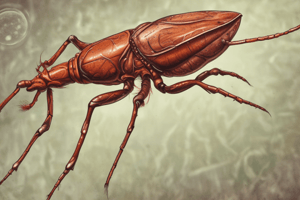Podcast
Questions and Answers
What disease is caused by the protozoan Trypanosoma cruzi?
What disease is caused by the protozoan Trypanosoma cruzi?
- Malaria
- Chagas’ disease (correct)
- Leishmaniasis
- African sleeping sickness
Which of the following is NOT a symptom of Chagas' disease?
Which of the following is NOT a symptom of Chagas' disease?
- Myocarditis
- Megacolon
- Fever
- Bacterial pneumonia (correct)
What is the primary means of transmission for Trypanosoma cruzi?
What is the primary means of transmission for Trypanosoma cruzi?
- Sexual contact
- Airborne particles
- Triatoma bug bites (correct)
- Contaminated water
In Chagas’ disease, Trypanosoma cruzi mainly affects which type of cell?
In Chagas’ disease, Trypanosoma cruzi mainly affects which type of cell?
What pathological effect does Trypanosoma cruzi have on the myocardium?
What pathological effect does Trypanosoma cruzi have on the myocardium?
Which of the following stages of Chagas’ disease is characterized by an asymptomatic phase?
Which of the following stages of Chagas’ disease is characterized by an asymptomatic phase?
What is the primary method used to diagnose Chagas' disease?
What is the primary method used to diagnose Chagas' disease?
What is the consequence of Trypanosoma cruzi infection in approximately 20 to 30% of infected individuals?
What is the consequence of Trypanosoma cruzi infection in approximately 20 to 30% of infected individuals?
What is the main purpose of xenodiagnosis in relation to T. cruzi infection?
What is the main purpose of xenodiagnosis in relation to T. cruzi infection?
Which statement best describes the pathology of African sleeping sickness caused by T. brucei gambiense?
Which statement best describes the pathology of African sleeping sickness caused by T. brucei gambiense?
What is a characteristic symptom following the invasion of the central nervous system by T. brucei?
What is a characteristic symptom following the invasion of the central nervous system by T. brucei?
How are T. brucei parasites primarily transmitted to humans?
How are T. brucei parasites primarily transmitted to humans?
What is the function of the ventral adhesive disc in Giardia intestinalis?
What is the function of the ventral adhesive disc in Giardia intestinalis?
What type of transmission method is associated with Giardia intestinalis infections?
What type of transmission method is associated with Giardia intestinalis infections?
Which symptom is commonly associated with Giardia intestinalis infection?
Which symptom is commonly associated with Giardia intestinalis infection?
What is the diagnostic method for identifying T. brucei in a patient?
What is the diagnostic method for identifying T. brucei in a patient?
Flashcards are hidden until you start studying
Study Notes
Trypanosoma cruzi (Chagas’ disease)
- Causes myocarditis and Trypanosoma-induced heart disease.
- Acute infections exhibit tropism for cardiac myofibers, implicated in chronic heart disease.
- Myocardial fibers suffer from myocytolysis and myofibrillar degeneration.
- Approximately 10% of infected individuals develop megacolon.
- Chronic infection results in scarring of the myocardium, affecting 20-30% of cases.
Signs and Symptoms of Chagas’ Disease
- Initial chagomas (swelling from insect bites).
- Generalized stage includes fever, swollen lymph nodes, myocarditis, splenomegaly, and esophagus/colon enlargement.
- Chronic stage may be asymptomatic for years before symptomatic heart failure occurs.
Transmission
- Transmitted via bites of Triatoma bugs, known as kissing bugs.
Location of Parasite
- Primarily found in the circulatory system; trypanosomes transform within macrophages and heart cells.
Means of Diagnosis
- Microscopic identification of trypanosomes or antigens in blood, lymph, spinal fluid, or tissue biopsy.
- Xenodiagnosis involves allowing uninfected kissing bugs to feed on suspected individuals, with subsequent dissection revealing infections.
Trypanosoma brucei gambiense (African sleeping sickness)
- Pathology includes meningoencephalitis, hemolytic anemia, and impaired consciousness; can lead to death if untreated.
Signs and Symptoms of African Sleeping Sickness
- Lesions form at fly bite sites, leading to fever, lymph node swelling, and headaches.
- CNS invasion results in severe drowsiness, abnormal neurological function, and coma.
Transmission
- Spread via bites from the tsetse fly (Glossina); cattle and sheep serve as reservoirs.
Location of Parasite
- Trypanosomes circulate in blood and lymph, with some entering the CNS.
Means of Diagnosis
- Microscopic observation of long, thin trypanosomes in blood, lymph, spinal fluid, or tissue biopsy, identifiable by their structure.
Giardia intestinalis (Beaver fever)
- Causes enterocyte damage, loss of intestinal brush border, and altered epithelial barrier function.
Signs and Symptoms of Beaver Fever
- Frequently asymptomatic but can lead to severe gastrointestinal distress.
- Symptoms include greasy, frothy, fatty diarrhea, abdominal pain, flatulence, nausea, vomiting, and low-grade fever.
- Characteristic “rotten egg” smell in patient stools indicates infection.
Transmission
- Primarily through ingestion of contaminated water or food containing cysts from feces.
Location of Parasite
- Trophozoites attach to intestinal lining via a ventral adhesive disc or remain free in the intestine.
Studying That Suits You
Use AI to generate personalized quizzes and flashcards to suit your learning preferences.





